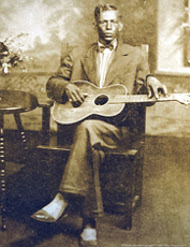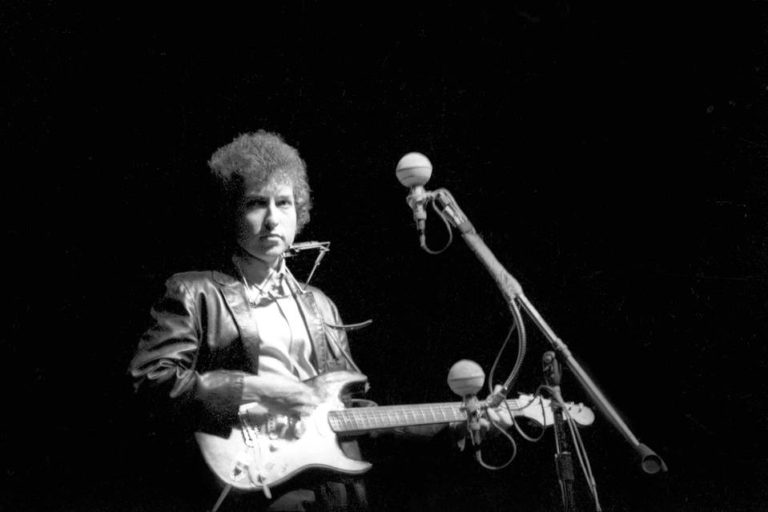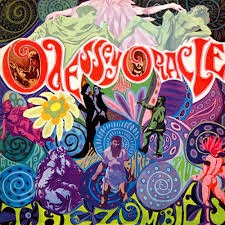Five exceedingly rare nineteenth century “blues” guitarists
“Always fun reading, Paul. Thanks.”
Jason Vivone (@JVivone), leader of the Billy Bats, Kansas City, December 3, 2013.
 |
| Charlie Patton: taught by Henry Sloan |
BLUESMUSE44. We ended last week’s post around 1910 on the streets of Dallas, Texas. It was five years
before
Huddie Ledbetter, also known as Lead Belly, began
the first of his prison sentences. His initial 1915 stretch, incidentally, was for
carrying a pistol (probably with intent). In 1918, Lead Belly would be banged up again,
this time for killing a man in a fight over a woman. And he wasn’t just any
man. He was Lead Belly’s relative. Bet you’re glad you weren’t in Lead Belly’s
family.
Lead Belly, then aged 32, was playing
guitar duets with a 17-year-old blind kid called Lemon Jefferson on the streets
of Dallas, Texas. It’s said Lead Belly taught Blind Lemon how to play boogie
guitar and, also, that Lead Belly was the first guitar player ever known to
play barrelhouse-piano style boogie on a guitar. This was in Shreveport, Louisiana, sometime
around 1899.
we know it today. Blues as a genre didn’t even have an official name until
1912; and very few African-American guitarists playing styles preceding blues were
operating before the turn of the twentieth century. I know of five off the top
of my head; but if you know of others, I’d be grateful if you could let me know.
Here they are:
in 1870 in Mississippi, who taught guitar to the young Charlie Patton, himself
later dubbed Father of the Delta Blues. Henry Sloan may even have written songs
thought to have been composed by Patton, such as ‘Pony Blues’. That’s what
blues pioneer Tommy Johnson once claimed, anyway. Henry
Sloan was also the first musician to
set field hollers to guitar accompaniment, according to the acclaimed American
music historian, Dr. David Evans.
 |
| Buddy Bolden band with Jefferson Mumford on guitar |
Galloway, born 1863, and Jefferson Mumford, born in 1873
were the exception in the late nineteenth century, rather than the rule. In the
1880s, the guitar was a middle class instrument for middle class people. Most
black musicians were unable to afford such luxury items until mail-order
catalogues made them both affordable and attainable later in the 1890s. Charlie
Galloway and Jefferson Mumford were a pair of barbers (like so many pioneer blues
musicians), both known to be playing on the streets of New Orleans, where they
were born, as far back as 1885. Both guitarists were there at the evolution of minstrel
songs to ragtime and ragtime to blues; and both had stints playing in New
Orleans’ famous Buddy Bolden band.
1870
another guitar style born that would strongly influence blues. In the Hawaiian
 |
| Joseph Kekuku invented slide guitar |
Islands around 1885,
a schoolboy called Joseph Kekuku, from the island of Oahu, picked up a metal
bolt on a railway track near Honolulu. He then made music by sliding the bolt
over the gut strings of his Portuguese guitar and Hawaiian guitar playing was
born.
is thought Hawaiian guitarists, demonstrating the new style at the Chicago
World’s Fair, introduced the idea of slide and bottleneck guitar to the USA, in
1893.
 |
| Daddy Stovepipe |
Stovepipe was known to have played in a mariachi band in Mexico in the late
1890s. He could well be the earliest known blues guitarist, if only we could
authenticate the music he was playing in the USA before going down to Mexico.
Called Daddy Stovepipe due to his stovepipe hat, Daddy’s real name was Johnny
Watson. He also recorded under the names of Jimmy Watson, Sunny Jim and the Reverend
Alfred Pitts.
ended.
It’s extremely likely that both Blind Lemon and Lead
Belly were both influenced by the music of Henry ‘Ragtime
Texas’ Thomas while on the road around Texas. Born to freed slaves
 |
| Henry ‘Ragtime Texas’ Thomas: the album |
in 1874 in
north-west Texas, Thomas was well over 50 when he recorded his seminal
collection of early African-American ‘reels, gospels, minstrel pieces, ragtime
numbers and blues’ in Chicago between 1927 and 1929. The songs of Ragtime Texas
Thomas, probably now considered country blues, have since been covered by bands
like Canned Heat, the Grateful Dead and Lovin’ Spoonful.
wrote David Evans, “For blacks in particular the
guitar lacked any residual associations with slavery, minstrel music and its
demeaning stereotypes, or even with the South.” Guitars were the most popular instruments, Dr. Evans said,
because they were not rural and traditional; and they carried an aura of
urbanity and upward mobility. As well as social reasons and its cheaper
price, the guitar’s greater sound range also helped it usurp the banjo. You
could emulate the chugging of a train on a guitar and use a bottle or knife as
a bottleneck or slide.
the redoubtable Alex Lomas once noted, the guitar was capable of sounding like
several parts at one. “The lone bluesman could pocket the fee for a whole orchestra.”
David K. Bradford quotes the African-American ballad
singer, songwriter and street evangelist, Charles Haffer, who once linked the
emergence of blues to the guitar’s new popularity among black musicians in the
1890s. Born in the 1870s, Haffer, from Mississippi, said, “I used to sing all
the old jump up songs. The blues weren’t in style then – we called them reels





Really enjoying this . Very informative and useful. Kevin
Pleased to hear you enjoyed the post, Kevin, and appreciate your feedback. Thank you very much.